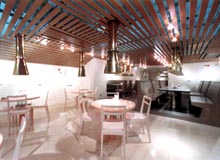UNLIKELY COMBINATIONS:
Consumers' Taste for Uncommon Products Grows
October 16, 2000
|
 |
|
Eating Korean-style food in a decidedly Western setting has made this restaurant a hit. (Yakiniku France-jin)
|
Avocado rolls and other unusual offerings that once would have been inconceivable to the Japanese have now become standard fare at sushi restaurants throughout the world. Similar examples abound in culinary and other realms in Japan. These days, not only restaurateurs but companies in all industries are finding that combining two seemingly incongruous items into a single product has the power to lure customers.
A Fragrant French Dessert
One Tokyo shop specializing in crepes, a popular dessert in Japan, recently came out with offerings made using the highly aromatic fermented soybeans known as natto. The new items--pairing natto with ingredients like coffee gelatin and pumpkin--were a hit, and the shop has reportedly sold more than 30 a day. While the original French crepes are generally filled with fruit sauce and heavy cream, the Tokyo shop hit on the wild idea of trying out natto combinations instead.
Natto is an extraordinarily nutritious food, rich in vegetable protein, and it has been shown to promote blood circulation by preventing clotting. Unfortunately, it gives off a pungent odor that puts off most foreigners and more than a few Japanese. Even many foreigners who have lived in the country for years and love Japanese food say that natto is one item they cannot bring themselves to try. One can only wonder how the French would react if they got a whiff of this Japanese culinary twist on the crepe.
A New Twist on Barbecue
Korean-style barbecued beef has long been popular in Japan, where it is called yakiniku. Nevertheless, restaurants serving this fare have suffered from a reputation as smoke-filled eateries. Women in particular tend to avoid eating there, since the smell of smoke clings to clothes and hair. Hoping to make a clean break from this image, one restaurant in Roppongi, one of Tokyo's amusement quarters, opened under the name Yakiniku France-jin (the yakiniku Frenchman). The restaurant's white walls and its circular, pink tables represent a complete departure from the conventional, smoky yakiniku restaurant experience.
Why, however, use the word "Frenchman" in the name? According to the owner, "Though France has absolutely nothing to do with Korean-style grilled meat, I thought that bringing two completely different concepts together would leave a lasting impression on the consumer." The name, which would undoubtedly confound Japanese and Koreans, not to mention French, has paid off. Since its opening, Yakiniku France-jin's 70 seats have been filled with young groups of women and company employees.
Mixed-up Electronics, Too
In a similar vein, Fuji Photo Film recently marketed a combination portable music player and digital camera. The listener uses a computer to load digital music data onto the unit from compact discs or the Internet and enjoys the music through earphones that connect to the body of the camera. Fuji Photo Film explains that by adding a music player to the camera, it hoped to create a product that users would see as something to take with them everywhere. Nevertheless, the union of two such disparate components still comes across as odd.
Commenting on the unusual foods and products that have hit the market recently, one specialist in consumer psychology says, "Japan is awash with goods, and there are few products left that people feel they have to have. Products combining incongruous elements create a stir because they transcend existing categories, and they thus appear novel in the eyes of consumers."
Back to Main Index
 Copyright (c) 2000 Japan Information Network. Edited by Japan Echo Inc. based on domestic Japanese news sources. Articles presented here are offered for reference purposes and do not necessarily represent the policy or views of the Japanese Government. Copyright (c) 2000 Japan Information Network. Edited by Japan Echo Inc. based on domestic Japanese news sources. Articles presented here are offered for reference purposes and do not necessarily represent the policy or views of the Japanese Government.
|



















